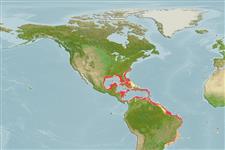>
Anguilliformes (Eels and morays) >
Muraenidae (Moray eels) > Muraeninae
Etymology: Gymnothorax: Greek, gymnos = naked + Greek, thorax, -akos = breast (Ref. 45335).
More on author: Cuvier.
Environment: milieu / climate zone / depth range / distribution range
Ecologie
marien rifbewoner; diepte 0 - 200 m (Ref. 9710), usually 0 - 35 m (Ref. 40849). Subtropical; 37°N - 26°S, 98°W - 5°W
Western Atlantic: North Carolina, USA and Bermuda to Brazil, including the Gulf of Mexico, the Caribbean to southeastern Brazil. Eastern Atlantic: Ascension and St. Helena (Ref. 4450). Mid- and eastern Atlantic islands (Ref. 26938).
Grootte / Gewicht / Leeftijd
Maturity: Lm ? range ? - ? cm
Max length : 200 cm TL mannelijk / geslacht onbekend; (Ref. 57911); common length : 60.0 cm TL mannelijk / geslacht onbekend; (Ref. 5217); max. gepubliceerd gewicht: 2.5 kg (Ref. 40637)
Moderate-size moray with a pattern of distinct small, round, overlapping dark brownish to purplish-black spots on white or pale yellow background (Ref. 26938).
A benthic and solitary species (Ref. 26340) abundant in shallow rocky and grassy areas and on coral reefs; less common in turbid bays or harbors. Its bite is very dangerous (Ref. 5217). Active during the day, sometimes together with other predators. Feeds on fish and crustaceans (Ref. 42064). Usually seen with its head protruding from a hole and the rest of its body concealed (Ref. 26938). Observed to be unusually aggressive towards man (Ref. 86997). It has been traded as aquarium fish at Ceará, Brazil (Ref. 49392). Marketed fresh and salted (Ref. 5217).
Levenscyclus en paargedrag
Maturities | Voortplanting | Spawnings | Egg(s) | Fecundities | Larven
Spawning migrations, leptocephalus larvae.
Robins, C.R. and G.C. Ray, 1986. A field guide to Atlantic coast fishes of North America. Houghton Mifflin Company, Boston, U.S.A. 354 p. (Ref. 7251)
Status op de Rode Lijst van het IUCN (Ref. 130435)
Gevaar voor de mens
Traumatogenic (Ref. 5217)
Gebruik door de mens
Visserij: van minder commercieel belang; Aquarium: Commercieel
Tools
Speciale rapporten
Download XML
Internetbronnen
Estimates based on models
Preferred temperature (Ref.
123201): 23.3 - 28, mean 26.5 °C (based on 630 cells).
Fylogenetische diversiteitsindex (Ref.
82804): PD
50 = 0.5000 [Uniqueness, from 0.5 = low to 2.0 = high].
Bayesian length-weight: a=0.00055 (0.00036 - 0.00083), b=3.27 (3.15 - 3.39), in cm total length, based on LWR estimates for this species & Genus-body shape (Ref.
93245).
Trofisch niveau (Ref.
69278): 4.5 ±0.8 se; based on diet studies.
Weerstandsvermogen (Ref.
120179): laag, minimale populatieverdubbelingstijd 4,5-14 jaar (Assuming tmax>10).
Fishing Vulnerability (Ref.
59153): Very high vulnerability (90 of 100).
Nutrients (Ref.
124155): Calcium = 10.1 [4.9, 20.1] mg/100g; Iron = 0.399 [0.211, 0.819] mg/100g; Protein = 19.5 [17.2, 22.0] %; Omega3 = 0.161 [0.064, 0.501] g/100g; Selenium = 32.8 [15.0, 68.8] μg/100g; VitaminA = 41.4 [10.9, 160.5] μg/100g; Zinc = 0.431 [0.281, 0.657] mg/100g (wet weight);
